|
The NAHLN Update |2012|
Volume 4, No. 1
THE OFFICIAL NEWSLETTER OF THE NATIONAL ANIMAL HEALTH LABORATORY NETWORK (NAHLN)
A STATE AND FEDERAL PARTNERSHIP TO SAFEGUARD ANIMAL HEALTH |
|
Founding Principles and Features of the NAHLN | |
- Quality management standards
- Competency of laboratory personnel
- Standardized diagnostic techniques
- Reference materials and equipment
- Secure communications and reporting system
- Adequate facilities to ensure biosafety/biosecurity levels
- Assessment of preparedness through scenario testing
|
|
|
| | |
For quick viewing, click below on the articles that interest you!
|
|
Input Welcome! | |
We appreciate hearing from you! Are there other topics that you would like to hear about?
Please e-mail your comments to us at
|
|
Current Number of Subscribers: | |
1597
|
|
Upcoming Events | |
2012 American Veterinary Medical Association (AVMA) Convention
August 3 - 7, 2012, San Diego, CA
55th Annual American Association of Veterinary Laboratory Diagnosticians (AAVLD)/115th U.S. Animal Health Association (USAHA) Annual Meeting
October 18 - 24, 2012, Greensboro, NC
Sixth International Conference on Antimicrobial Agents (AAVM 2012)
October 23 - 26, 2012, Washington, DC
2013 Conference of Research Workers in Animal Disease (CRWAD) Meeting
December 8 - 10, 2012, Chicago, IL |
|
|
|
Note from the Coordinator |
NAHLN reaches a significant milestone this year; we're turning 10! In our next several issues, we will share our accomplishments over the past decade.
In 2002, two USDA agencies, APHIS and the National Institute of Food and Agriculture (NIFA - formerly known as CSREES), in collaboration with the American Association of Veterinary Laboratory Diagnosticians (AAVLD) formed the National Animal Health Laboratory Network (NAHLN). Our goal was to increase this country's capability and capacity to address adverse animal health events.
Initially, the NAHLN was comprised of 12 laboratories representing 12 States across the U.S. Today, we've grown to include 57 State and university diagnostic laboratories and five Federal facilities (Department of Defense Food Analysis and Diagnostic Laboratory, Ft. Sam Houston, Texas; Department of the Interior Laboratory in Madison, Wisconsin; the Food Safety and Inspection Services Laboratory in Athens, Georgia; and the National Veterinary Services Laboratories [NVSL], Ames, Iowa and Plum Island, New York campuses), for a total of 62 laboratories in 40 States.
Proficiency Testing and Train the Trainer
- 2004 - Two individuals representing each of 12 laboratories were trained and proficiency tested for classical swine fever (CSF) and foot-and-mouth disease (FMD) virus. This marked the first time that personnel in State and university laboratories were trained and proficiency tested for CSF or FMD.
- 2005 - Fewer than half of the personnel originally proficiency tested was still working in the NAHLN laboratories. The Train the Trainer program was established to ensure an adequate number of analysts were trained and proficiency tested to test the large number of samples that would be generated during animal health emergencies. Four courses were held throughout the U.S. (California, Georgia, Texas, and Wisconsin) utilizing NVSL subject matter experts from the Foreign Animal Disease Diagnostic Laboratory and the Diagnostic Virology Laboratory to train individuals from 27 NAHLN laboratories for CSF, FMD, AI, and ND. After returning to their laboratories, individual analysts were required to successfully complete proficiency testing prior to training others in their laboratories.
- 2012 - There are currently 161 people trained and proficiency tested for CSF and FMD. 146 (91%) were trained through the Train the Trainer program. There are currently 211 people trained and proficiency tested for AI and ND. 197 (93%) were trained through the Train the Trainer program.
The table below shows the incremental growth of laboratory disease approval and approved analysts in the NAHLN laboratories. In our next issue we'll review the testing capacity throughout the Network.

Some new news this month....I wanted to make you aware that NVSL is now using USDA's GovDelivery system via the new Veterinary Services (VS) Stakeholder Registry. GovDelivery is an electronic news service which can provide our stakeholders with notices, updates and electronic reminders for happenings throughout VS.
The new VS Stakeholder Registry allows NVSL and the NAHLN to establish regular channels of communication and enhance relationships with our clients. The Registry allows our stakeholders to choose what topics to follow, how to receive them (by e-mail or text message), and how often (daily or weekly). Use of this platform also supports VS's vision for stakeholder engagement, VS' strategic plan, and our mission.
We encourage you to sign up to receive up-to-date notices about NVSL and other areas within VS. To sign up for the Animal Health Stakeholder Registry, click the red envelope below or follow this link.

Sincerely,

Barbara M. Martin
Coordinator
National Animal Health Laboratory Network
USDA APHIS VS NVSL
|
|
|
|
|
Veterinary Services Memorandum 580.4 Simplified | |
The purpose of this memorandum is to provide Veterinary Services (VS) policy and procedure for the investigation and communication of a potential foreign animal disease (FAD) or emerging disease incident (EDI) investigation. Each investigation must be officially initiated and carried out by State or Federal veterinarians trained especially for this purpose.
A classification of high suspicion, intermediate suspicion or low suspicion is given based on the findings during the investigation, including clinical signs and epidemiology of the disease course. Sample collection, transport, testing, and reporting are expedited under certain circumstances, including high suspicion of disease and/or if commerce is delayed or stopped pending the results of diagnostic testing. These investigations are designated as Priority 1 or Priority A respectively. In the case of a Priority 1 or Priority A, State and national officials are notified when these high priority investigations are initiated so they will be ready should test results confirm the presence of an FAD or EDI.
The memorandum incorporates the responsibilities of many different groups involved in completing in FAD/EDI investigation. Investigations must be initiated by either the State animal health official (SAHO) or area-veterinarian-in-charge (AVIC). Specially trained State or Federal veterinarians known as foreign animal disease diagnosticians (FADD) are assigned to investigate credible reports of potential high consequence animal disease. This includes conducting site visits, performing physical examinations of the affected animals, collecting diagnostic samples, and assigning a classification and designation after discussion and agreement with the SAHO and AVIC. Once a designation of Priority 1 or Priority A has been assigned, a notification chain is followed to communicate with various individuals and groups, so they are prepared in case of a positive test. If test results are positive for an FAD, this is immediately reported to the same groups who have been preparing to respond, resulting in a smooth transition to action.
Awareness and training are very important when a process involves many different groups. According to VS Memo 580.4, information must flow from the field to the laboratory to those who must decide how to best respond to the issue at hand. NAHLN has developed a course designed to bring together representatives from all the groups involved in the investigation and communication of a potential FAD or EDI investigation. Following a thorough review of the information in VS Memo 580.4, the groups work through different scenarios and "perform" as they would in their positions during an actual investigation. Communication occurs during the scenario between the field and laboratory, the field and management, and the laboratory and management, just as it would during an actual event. Participants in the course are able to witness the unfolding of a complex system and ask clarifying questions as it is happening. This course and the scenarios can be tweaked to focus on any one of the groups so their role can be emphasized and practiced while they are learning how the other groups fit into the process. NAHLN plans to offer this training again in the near future and we look forward to developing it into a tool that many groups can use to improve preparedness.
Article submitted by Christina Loiacono, Associate NAHLN Coordinator, NAHLN Program Office, USDA APHIS VS NVSL, Ames, Iowa
|
|
Getting to Know Us - Fernando Torres-Velez | |
On June 3, 2012, Fernando Torres-Velez was named Director of NVSL's Foreign Animal Disease Diagnostic Laboratory (FADDL). Prior to this appointment, he served as acting Director on a rotational basis since August 2011. He has also previously served as Head of the FADDL's Diagnostic Services Section, where he supervised staff veterinarians, scientists, and technicians working in the diagnosis of transboundary and emerging infectious diseases. He initially arrived at FADDL in June 2010 as Head of the Reagents and Vaccine Services Section.
Torres-Velez, a native of Puerto Rico, earned his Bachelor of Science degree from Colorado State University (Fort Collins, Colorado) and his DVM from Tuskegee University (Tuskegee, Alabama). He completed postdoctoral work in emerging infectious diseases at the Centers for Disease Control and Prevention (CDC) located in Atlanta, Georgia, before joining the University of Georgia (UGA), Athens, Georgia, as a pathology resident. Subsequent to pathology training, Fernando conducted his PhD research in Nipah virus in a cooperative project between the UGA and the CDC. As an Assistant Research Scientist at UGA/CDC, he participated and led numerous international projects in the Americas, Caribbean, and the Middle East. Before joining NVSL, Fernando led the Infectious Diseases Pathogenesis Section at the National Institute of Health (NIH), National Institute of Allergy and Infectious Diseases located in Bethesda, Maryland.
Collaboration with FADDL is an important facet of NAHLN. Since his arrival, Fernando has brought his valuable experience and fresh perspective to contribute to topics in support of NAHLN, such as: discussions of assay development and validation and laboratory concept of operations at the National Center for Foreign Animal and Zoonotic Disease Defense (FAZD) Agriculture Screening Tools workshops; planning for additional assays to be deployed to the NAHLN laboratories; and revisions to the Veterinary Services Memorandum 580.4, which provides the procedures for investigating a suspected foreign animal or emerging disease incident.
The NAHLN thanks you, Fernando, for your contributions to the success and growth of the program. Congrats on your new position at FADDL!
 | |
Fernando Torres-Velez
Director, Foreign Animal Disease Diagnostic Laboratory
USDA APHIS VS NVSL |
Interviewed by Jill Brown, Program Analyst, NAHLN Program Office, USDA APHIS VS NVSL, Ames, Iowa
|
| QA Update | |
What Makes a Good Quality Manager?
Across our country, the quality managers in our veterinary diagnostic laboratories have many different skill sets and talents, and may also have differing opinions about how a quality system should be managed. Over the past couple of weeks, I have been reminded that, although I am the quality manager, I am certainly not above making mistakes. This is why it's important to include an audit of quality system practices with internal audits to make sure aspects of the quality system managed and performed by the quality manager are being done appropriately. This may be difficult if there are no staff members in the lab qualified to evaluate the quality system. Quality managers may have to specially train auditors to assess the quality system, or use someone from outside, such as a quality manager from a nearby laboratory.
Quality managers often have widely ranging opinions about how their jobs should be done. We have job descriptions, but there is little guidance about the practicalities of being a quality manager. Following is a list of things I think are important for a quality manager to consider and practice:
- Know the AAVLD Requirements, NAHLN Requirements, and any accreditation requirements applicable to your laboratory well and; seek clarification from authorities when needed
- Be open to admit mistakes and problems with the system; this encourages others to be more relaxed when they make mistakes
- Keep a positive attitude and take every opportunity to find humor and share it, especially when it relates to quality (in a good way, of course)
- Be a facilitator - quality managers are there to assist the laboratory staff in solving problems, but not to solve problems for them
- Be diplomatic - it's important to maintain professionalism in the workplace
- Work with people's ideas - many times the laboratory staff have great ideas
- Make as much quality information available to the lab staff and management as possible - laboratory staff that are more aware of the status of their CARs, etc. are more likely to process them appropriately
- Send friendly reminders - we all have schedules to keep and the laboratory staff are providing test results to clients. Keep things on their radar in a friendly way.
- Keep in mind that perfection is not possible, and everyone makes mistakes (if not, we wouldn't need quality managers)
- Encourage continuous improvement by monitoring and measuring processes and share that information with the staff
- Point out opportunities for improvement in a positive way
- Keep up with current thinking and practices in veterinary laboratory quality
- Keep communication open with other peer laboratories, not only to benefit quality, but to benefit the laboratory staff
- Cultivate a laboratory culture that accepts change when it is needed to improve a process; change can be good
- Help staff to remember that if they consistently do their best, then their best will consistently get better
Having the right quality manager can lead to a very successful quality program. Ongoing training is critical. Communication with other quality managers is also necessary. Attending professional meetings, like the AAVLD Quality Assurance Committee meeting, is important to stay up with current practices and interpretations of the Requirements. What are some important things the quality manager does in your laboratory that you find helpful or important? I would be interested in collecting these facts. If you have feedback for me about something you like about how your quality manager handles things, please e-mail them to me at plukens@vetmed.wsu.edu.
Article submitted by Patricia Lukens, Quality Systems Manager, Washington Animal Disease Diagnostic Laboratory, Washington State University, Pullman, Washington
|
| New Testing Algorithm Implemented for SIV Surveillance | |
On June 11, 2012 a new testing algorithm for SIV surveillance was implemented across the NAHLN laboratories. The changes in the algorithm are designed to broaden the swine influenza surveillance efforts to better monitor the ecology of the viruses in the U.S. (objective 1 of the surveillance plan).
The revised algorithm was proposed by the NAHLN Methods Technical Working Group (MTWG). Prior to implementation, it was reviewed and commented on by the NAHLN laboratories and NVSL's Diagnostic Virology Laboratory (DVL) to ensure practicality.
The new algorithm consists of starting with an influenza matrix PCR; performing H and N sub typing PCRs on any matrix positive; and conducting virus isolation. A portion of the virus isolates are sequenced and then the sequences are deposited to GenBank. This provides important information about the nature of the virus to all interested stakeholders. Additional requirements are also provided including immediate notification and shipment of samples to NVSL should there be human involvement. Each step of the newly released algorithm is associated with a timeline for testing and reporting guidance for the laboratories. The new algorithm will be reviewed and revisited within six months for any necessary changes.
A number of additional changes were required prior to implementing the new algorithm. These included modification of the data collection method to accommodate the additional assays. Further, the blanket purchase agreements had to be modified in order to reimburse the laboratories for each step of the new algorithm.
This entire process required many steps and attention to details by all involved. We very much appreciate the time and effort invested by the MTWG, NAHLN laboratories, DVL, the National Surveillance Unit, and Life Technologies in implementing the new SIV algorithm.
Article submitted by Sarah M. Tomlinson, Associate NAHLN Coordinator, NAHLN Program Office, USDA APHIS VS NVSL, Fort Collins, Colorado
|
| Agricultural Screening Tools Workshops' Impact on NAHLN | |
The National Center for Foreign Animal and Zoonotic Disease Defense (FAZD) has hosted a series of Agricultural Screening Tools (AST) workshops over the past two years. The first two AST workshops focused on defining agricultural screening tools, evaluating the current status, and identifying the gaps for needed diagnostic development -- including policy and obtaining input on prioritization of the needs for the tools. A wide range of stakeholders participated in the workshops including representatives from industry, academia, State, and Federal government.
Several key assay development and validation projects that involve NAHLN laboratories were prioritized and initiated based on the outcome from AST I and II. An RT-PCR assay for foot-and-mouth disease (FMD) in milk has been developed and is currently in the validation process through an inter-laboratory comparison study, which will be followed by a negative cohort study in five NAHLN laboratories. This project is a collaborative effort between FAZD, NVSL's Foreign Animal Disease Diagnostic Laboratory (FADDL), the Institute for Animal Health in Pirbright, Surrey, UK and several NAHLN laboratories. Additionally, a negative cohort for an FMD serologic assay is planned for 2012 as a collaborative effort with FADDL and the NAHLN laboratories. NAHLN laboratory training, proficiency testing, and readiness to deploy serology in the event of an FMD outbreak was identified as a high priority in the AST discussions. The need to determine the fitness of purpose of an FMD penside test and develop associated policies for the use of penside assays was also highly ranked by AST I and II participants. As a result, FADDL and two NAHLN laboratories participated in a pilot negative cohort study in January 2012; a larger negative cohort study in collaboration with FAZD will be conducted this summer to provide information on the performance characteristics of the penside assay and inform decision-making on future application. See the article entitled "Update on NAHLN Negative Cohort Studies" for more detailed information on these and other 2012 studies.
The third and the fourth AST workshops shifted gears to address laboratory specific concept of operations (CONOPS) and policies.
In October 2011, AST III was held in Des Moines, Iowa. Participants included National Animal Health Laboratory Network (NAHLN) stakeholders consisting of: State Animal Health Officials, American Association of Veterinary Laboratory Diagnosticians (AAVLD) representatives, NAHLN laboratory directors, animal industry representatives, FAZD personnel, Department of Homeland Security representatives, and personnel from various units across Veterinary Services. The goal of this workshop was to gather input from the experts in preparation for drafting policies related to the diagnosis of, and laboratory response to, foreign animal disease (FAD) outbreaks.
Three discussion groups addressed policy and CONOPS for the following topics:
- Use of diagnostic assays during an outbreak-specifically business continuity and availability and status of diagnostic tests discussed in AST I and AST II;
- Laboratory operations during an outbreak-specifically the use of BSL-2/BSL-3 space and Select Agent considerations;
- Laboratory sample and reagent prioritization-specifically sample triage and prioritization, reagent prioritization and procurement, and activation of NAHLN.
The outcome from the three expert panels was a series of recommendations that included:
- Determine processes for establishing additional laboratories to conduct confirmatory testing;
- Develop a policy and procedure for validating assays during an outbreak;
- Develop guidelines for testing in BSL 2 and BSL 3 laboratory space during an outbreak;
- Maintain an inventory of NAHLN laboratories with current Select Agent Program registration and approved agents;
- Identify the process and fast-track Select Agent registration or exemptions;
- Develop national surveillance plan options for start of an outbreak;
- Implement a national data system to manage data generated in an outbreak.
These recommendations carried forward into the planning of the fourth AST workshop, which was held in May 2012 at the National Centers for Animal Health in Ames, Iowa. Many of the same stakeholder groups were represented, but by fewer participants. The aim of AST IV was to discuss in detail the guidelines to address the recommendations from AST III. Specifically the group discussed:
- The use of diagnostic assays during an outbreak, using the FMD assays as an example;
- Prioritization of testing samples collected from different zones, sources and purposes during an outbreak;
- Biosafety Level testing requirements for laboratories conducting diagnostics during an outbreak;
- Application of Select Agent Regulations during an outbreak;
- Test validation and approval process during an outbreak.
The in-depth discussions of the above topics were captured and over the next few months will be developed into to draft VS guidance documents specific to laboratory CONOPS, similar to the FAD Preparedness and Response Plan (Prep) series of documents. The laboratory CONOPS document will be a valuable reference for NAHLN laboratories and State and Federal regulatory officials preparing for and responding to a disease outbreak event. To our knowledge, no such guidelines exist that are specific to laboratory operations and actions-a need identified and now moving towards completion as a result of the AST workshops.
Article submitted by Sarah M. Tomlinson, Associate NAHLN Coordinator, NAHLN Program Office, USDA APHIS VS NVSL, Fort Collins, Colorado
|
| NAHLN Surveillance Update | |
NAHLN has collaborated with other groups within APHIS, the National Veterinary Services Laboratories, Wildlife Services, National Surveillance Unit, National Center for Animal Health Programs, and the National Center for Animal Health Emergency Management, to implement surveillance programs. Currently, NAHLN laboratories are participating in surveillance programs for bovine spongiform encephalopathy (BSE), classical swine fever (CSF), chronic wasting disease (CWD), scrapie, swine influenza virus (SIV), and swine pseudorabies virus (PRV).
NAHLN laboratories play a critical role in VS surveillance programs by providing rapid standardized testing and results reporting for the above-mentioned diseases that are targeted in national animal disease surveillance initiatives.
Testing data provided in The NAHLN Update are based on results data that are available at the time of release of the newsletter. Testing numbers may change in future reports as new information is received and testing data are updated (see article in Volume 3, No. 2 edition titled, "Data dynamics within the SIV Surveillance Program, Why do the reports change?").
 Bovine Spongiform Encephalopathy (BSE) Surveillance Bovine Spongiform Encephalopathy (BSE) Surveillance
On April 24, 2012, USDA Chief Veterinary Officer John Clifford released a statement regarding detection of BSE in the United States. As part of the targeted surveillance system, the USDA APHIS confirmed the nation's fourth case of BSE in a dairy cow from central California. The animal at no time presented a risk to the food supply or human health. For the full release statement and further updates, go to: http://www.aphis.usda.gov/newsroom/hot_issues/bse/index.shtml.
The USDA has conducted surveillance for bovine spongiform encephalopathy (BSE) since 1990. In 2004, following the December 2003 detection of BSE in an imported cow, USDA implemented an enhanced BSE surveillance program to more accurately determine the prevalence of the disease in the U.S. cattle population.
USDA concluded that the prevalence of BSE in the United States is extremely low (less than 1 case per million adult cattle), and in 2006, transitioned to an ongoing BSE surveillance program that tests at a level more commensurate with this extremely low level of risk. Ongoing BSE surveillance exceeds guidelines set forth by the World Organization for Animal Health (OIE), providing for testing at a level 10 times that which is recommended by OIE.
The NAHLN laboratories have provided BSE surveillance testing since 2004. Currently, six NAHLN laboratories provide diagnostic testing for the BSE surveillance program. These laboratories continue to conduct testing to detect BSE at the very low level of less than 1 case per million adult cattle, assess any change in the BSE status of U.S. cattle, and identify any rise in BSE prevalence in this country. The NVSL Pathobiology Laboratory in Ames, Iowa performs surveillance and confirmatory testing on all samples identified as suspect (potential positive) for BSE by the NAHLN laboratories.
The chart below shows sample testing performed, by Quarter, for BSE by NAHLN laboratories (not including NVSL) in Federal fiscal year (FY) 2011 and Quarters 1 and 2 of FY 2012. The total number of samples tested for BSE by NAHLN laboratories in FY 2011 (October 2010 through September 2011) was 39,598 and 20,795 for Quarters 1 and 2 of FY 2012 (not including NVSL).
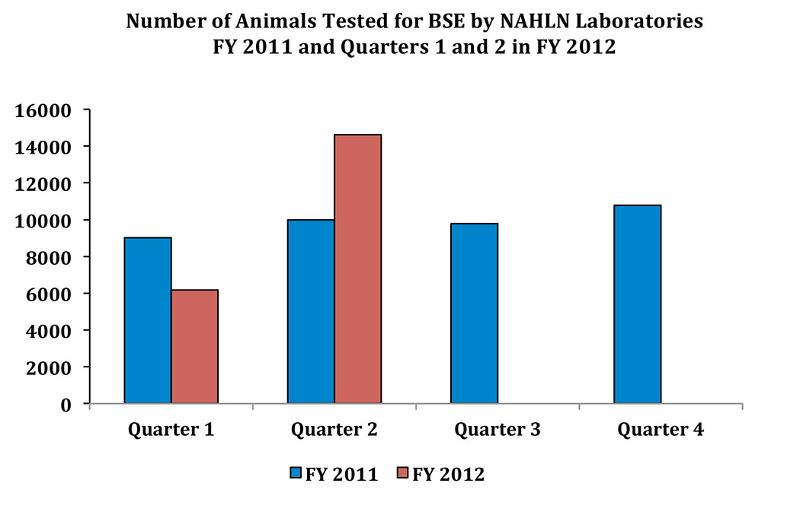
 Classical Swine Fever Surveillance Classical Swine Fever Surveillance
The classical swine fever (CSF) surveillance program was initiated in 2006 to rapidly detect CSF virus and monitor the risk of introduction of the virus in the U.S. swine herd. The surveillance program targets five specific swine populations for testing:
- Sick pig submissions to veterinary diagnostic laboratories (VDLs)
- Slaughter swine with high risk of CSF exposure
- Feral swine
- Swine populations (including waste feeding operations)with high risk of CSF exposure in Florida, Texas, and Puerto Rico
- Swine highly suspicious for CSF and entered into a Foreign Animal Disease Investigation
NAHLN laboratories conduct CSF surveillance testing and NVSL's Foreign Animal Disease Diagnostic Laboratory (FADDL) is the CSF confirmatory laboratory. In FY 2011, 19 NAHLN laboratories provided diagnostic testing for the CSF surveillance program.
The table below shows the number of animals tested for CSF by NAHLN laboratories in three surveillance target populations in FY 2008 through FY 2011. Feral swine test counts are not included here - see article titled "WS Surveillance and Emergency Response". Waste feeder/high-risk data are not available.

Information on feral swine serologic CSF testing can be found in the article below titled "Wildlife Services' Surveillance and Emergency Response."
 Chronic Wasting Disease (CWD) Surveillance Chronic Wasting Disease (CWD) Surveillance
Since 2001, USDA has worked to develop and implement a CWD program to prevent and control this disease in farmed/captive cervids, establish a national CWD Herd Certification Program, and assist States and tribes in CWD surveillance in wild deer, elk, and moose. The CWD program supported ongoing surveillance in farmed cervid herds to detect CWD-positive animals and follow-up investigations to trace CWD-infected animals to epidemiologically linked herds.
In FY 2011, 15,337 and in Quarters 1 and 2 of FY 2012, 12170 farmed/captive cervids were tested for CWD by NAHLN laboratories. The NVSL Pathobiology Laboratory in Ames, Iowa performed confirmatory testing on all samples identified as suspect (potential positive) for CWD.
The chart below shows the number of farmed/captive cervids tested, by Quarter, for CWD in FY 2011 and FY 2012 by NAHLN laboratories (not including NVSL).
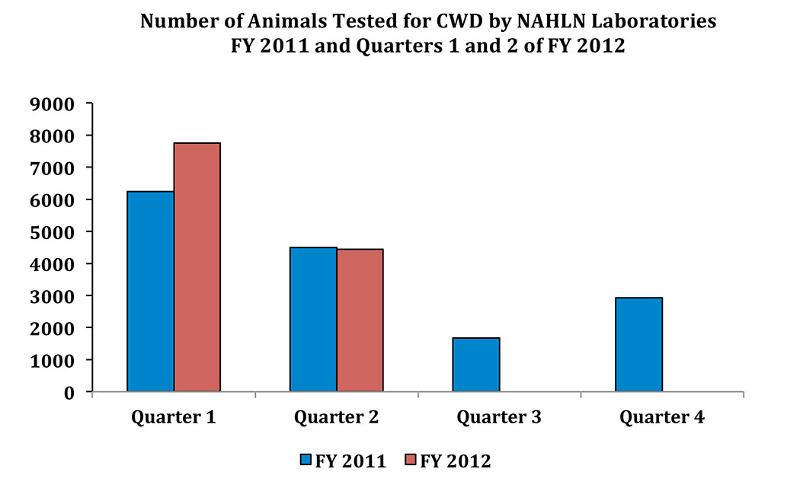
Due to a reduction in the Federal FY 2012 budget, the CWD program experienced significant changes, effective January 1, 2012. These changes included APHIS-approved laboratories and the NVSL using established user fees and charging producers directly for routine CWD testing. NVSL continues to conduct confirmatory testing on any presumptive CWD positive samples from farmed and wild cervids.
 Scrapie Surveillance Scrapie Surveillance
USDA initiated the National Accelerated Scrapie Eradication Program in 2001 with the goal of eradicating scrapie from the U.S. sheep and goat populations. Since 2003, surveillance for the program has been conducted primarily through the Regulatory Scrapie Slaughter Surveillance (RSSS) program, which targets sheep and goat populations that have been recognized as having higher than average scrapie prevalence.
Other scrapie surveillance also targets scrapie-exposed and potentially exposed sheep and goats found through investigations of infected animals; clinical-suspect animals and other mature sheep and goats submitted to veterinary diagnostic laboratories; rabies-suspect animals that test negative for rabies; and voluntary on-farm testing of flocks with risk factors for scrapie or as part of the Scrapie Flock Certification Program.
Currently, 19 NAHLN laboratories are approved to conduct diagnostic testing for scrapie surveillance. The NVSL Pathobiology Laboratory in Ames, Iowa performs confirmatory testing on all samples identified as suspect (potential positive) by the NAHLN laboratories.
In FY 2011, 37,756 and in Quarters 1 and 2, 29,731 animals were tested for scrapie by NAHLN laboratories. The charts below show the number of animals submitted, by Quarter, for scrapie testing by NAHLN laboratories in FY 2011 and Quarters 1 and 2 of FY 2012 (not including NVSL).
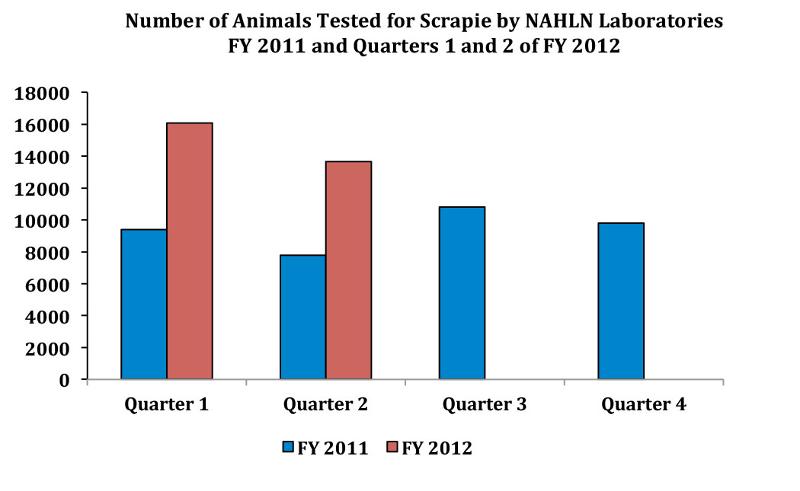
 Swine Influenza Virus Surveillance Swine Influenza Virus Surveillance
The goals of the swine influenza virus (SIV) surveillance program are (1) to monitor the genetic evolution of endemic SIVs to better understand endemic and emerging influenza virus ecology, (2) make SIV isolates and associated epidemiologic data available for research and analysis, and (3) select proper isolates for the development of relevant diagnostic reagents, updating diagnostic assays, and vaccine seed stock products. The program was initiated in May 2009 with a focus on monitoring the pandemic H1N1 2009 [pH1N1 (2009)] virus in swine. As the human health threat of pH1N1 (2009) declined in 2010, SIV surveillance efforts were re-focused on monitoring all current circulating SIVs. Also in 2010, an anonymous submission protocol was adopted to encourage more industry participation and increase the number of samples available for monitoring SIV in the U.S. swine herd. SIV surveillance efforts are targeted towards these three swine populations:
- Case-compatible sick pig submissions to VDLs
- Swine exhibiting influenza-like illness at first points of concentration or commingling events i.e., markets, fairs
- Swine populations that are epidemiologically linked to confirmed human cases involving SIV
NAHLN laboratories conduct SIV surveillance for the above-mentioned streams. The NVSL Diagnostic Virology Laboratory in Ames, Iowa is the SIV confirmatory laboratory.
SIV testing results reported by NAHLN laboratories
in FY 2011 and Quarters 1 and 2 in FY 2012
The table below shows the number of herds (accessions) tested, number of influenza-positive herds, and number of herds with virus sub-typing results reported in FY 2011 and Quarters 1 and 2 of FY 2012.
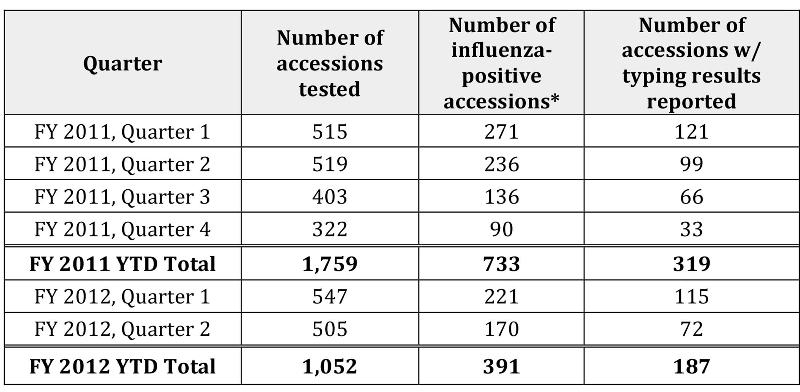
*Influenza-positive accessions are those with samples with positive matrix assay results
319 accessions had subtyping results reported in FY 2011. Mixed subtyping results (including multiple subtypes present and dual positives) were reported in seven accessions.
The chart below provides graphical representation of the frequency of SIV virus subtypes collected as part of SIV surveillance in FY 2011.

If an accession had samples with more than one subtype, it is counted in each subtype group in the pie chart above.
For details on the new testing algorithm for SIV surveillance recently implemented in the NAHLN laboratories, go to the article titled "New Testing Algorithm Implemented for SIV Surveillance."
 Swine Pseudorabies Surveillance Swine Pseudorabies Surveillance
The pseudorabies (PRV) surveillance program was initiated in 2009 as an extension of USDA's successful PRV eradication efforts. The program gathers surveillance data to support three specific objectives: (1) rapidly detect PRV entry and infection in U.S. commercial swine, (2) demonstrate freedom from PRV in commercial herds, and (3) monitor domestic sources of PRV.
Targeted Populations (surveillance streams)
- Investigation and diagnosis of suspicious PRV cases
- Sick pig submissions to veterinary diagnostic laboratories (VDLs)
- Herds participating in routine serology and herd profiling
- Herds classified as high risk
- Herds with reported exposure to feral swine
- Cull sow-boars at slaughter
- Market swine at slaughter
- Feral swine
PRV-approved NAHLN laboratories test serologic samples from domestic swine for four targeted PRV surveillance populations: sick pig submissions, routine serology and herd profiling, high risk swine populations, and swine with known feral swine exposure. NAHLN laboratories also conduct PRV testing for domestic swine samples that are submitted as part of epidemiologic traceback investigations. Fourteen NAHLN laboratories conducted PRV surveillance sample testing in domestic swine in FY 2011. Two NAHLN laboratories conducted PRV testing on feral swine samples (see article titled "WS Surveillance and Emergency Response"). The NVSL Diagnostic Virology Laboratory performs confirmatory testing for suspect and positive submissions for PRV.
In FY 2011, 332,129 and FY 2012, the first two quarters, 137,243 swine samples were tested under the PRV surveillance program in the following streams: diagnostic laboratory serologic submissions, sow-boar slaughter, and market slaughter. NAHLN laboratories tested 27,994 swine in FY 2011; and 8,758 swine in the first two quarters of FY 2012 for the diagnostic laboratory stream. Information on feral swine serologic submissions tested for PRV by selected NAHLN laboratories can be found in the article below titled "Wildlife Services' Surveillance and Emergency Response."
The surveillance information in this article has been provided by the responsible USDA APHIS offices.
Charts in this article are based on information and test results available at the time of report generation. Numbers are subject to change due to later reporting of test results and updates in the database(s).
|
|
Wildlife Services' Surveillance and Emergency Response | |
The USDA APHIS WS National Wildlife Disease Program (NWDP) was developed to implement a nationally coordinated surveillance and emergency response system in wildlife. Its purpose is to safeguard American agriculture, human health and safety, and wildlife populations. The NWDP is integrated with existing national animal health surveillance infrastructures, such as the NAHLN, to provide an important component in securing animal health, animal-based export trade, and safeguarding public health. With the assistance of State, tribal, Federal, and private cooperators, the NWDP has conducted surveillance and management of over 100 pathogens, toxins, or disease syndromes at local, regional, national, or international scales.
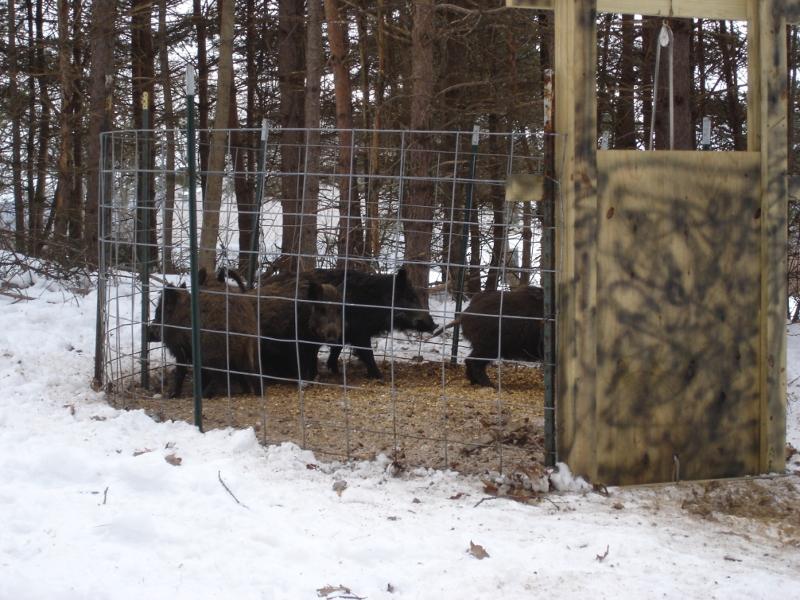 | |
Feral swine captured in trap, New Hampshire
Photo courtesy of Anthony Musante |
The charts below show the number of feral swine samples tested during Federal fiscal year (FY) 2011 and 2012 (October 2010 - February 29, 2012) for classical swine fever (CSF), pseudorabies virus (PRV), and swine brucellosis (SB) -- testing was performed either by APHIS personnel or NAHLN laboratories. NAHLN laboratories also tested feral swine for swine influenza virus.
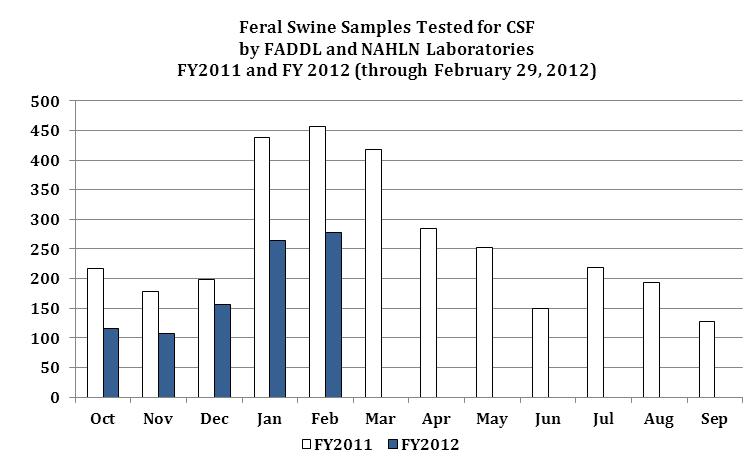
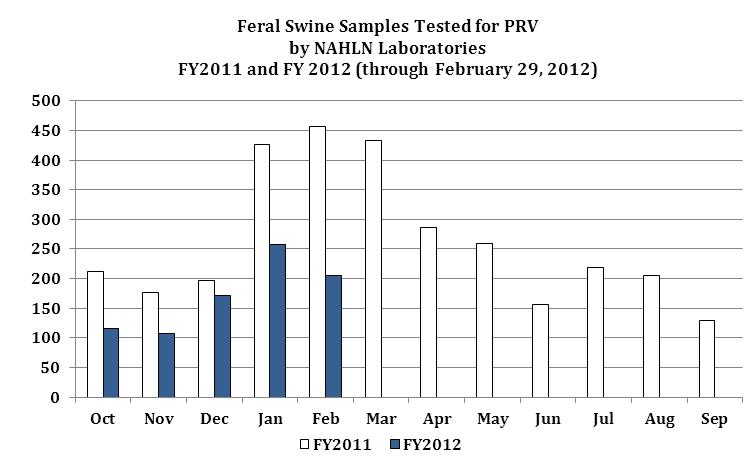

Article and chart data submitted by Thomas DeLiberto, National Wildlife Disease Coordinator, USDA APHIS WS NWDP, Fort Collins, Colorado
|
|
Update on NAHLN Negative Cohort Studies | |
Inter-laboratory comparison and negative cohort studies are important steps in the assay validation process. We use these studies to:
- Gather data that informs us about how the test performs in negative populations, providing specificity parameters;
- Identify any agents we can expect to cross react; and
- Overall provide information on the fitness of purpose and how we might be able to and might NOT be able to use this assay in the future. We will use this info to help inform our policy decisions.
2010-2011 Studies Report
In 2010 and 2011, negative cohort studies were conducted in the NAHLN laboratories for foot-and-mouth disease (FMD), African swine fever (ASF), and Rinderpest (RP). The studies were carried out in cooperation with the NAHLN laboratories and NVSL FADDL's Proficiency Validation Services Section in Plum Island, New York. The studies were undertaken in 2010 with the primary objective to further validate the rRT-PCRs for FMD, ASF and RP. Additionally the studies provided the opportunity for the NAHLN laboratories to:
- Assess and improve laboratory procedures and processes for sample selection, testing, and result communication;
- Assess and implement current notification/communication protocols for these foreign animal diseases; and
- Recommend improvements for the overall NAHLN laboratory surveillance component of future surveillance systems involving these diseases in NAHLN laboratories.
A total of 8,571 samples were collected and tested by 11 NAHLN laboratories in 2010-2011. In the course of the studies, only one false positive FMD test was reported from one NAHLN laboratory. Therefore, the point estimate for specificity for FMD is >0.99 in ovine and 1.00 for the remaining species. The point estimates for specificity for ASF and RP are both 1.00. Assay Performance Characteristic Summary Sheets are being developed and will be produced as a reference for the rRT-PCR assays for FMD, ASF, and RP and posted on the NAHLN website.
Figure 1-FMD, ASF and RP 2010-2011 Negative Cohort Sample Totals by Species

As the result of the communication and protocols established in preparation for these studies between NAHLN, NVSL FADDL, the VS Area Veterinarians in Charge, and the State Animal Health Officials of the participating States-the FMD false positive was handled very smoothly. All parties involved were notified according to the protocols; all sample material was forwarded to NVSL FADDL for confirmatory testing; and the sample was determined to be negative.
These studies have allowed NAHLN program staff to develop processes for designing and implementing these studies, which include open communication with the stakeholders. For all NAHLN studies, State Animal Health Official (SAHO) understanding and consent is vital prior to the NAHLN laboratory participating as well as the development and agreement of notification procedures for any false positive test results received during negative cohort studies.
Update on 2012 Studies
FMD Penside Negative Cohort Completed
In January of 2012, two NAHLN laboratories completed a small negative cohort study for a FMD penside assay. The FMD penside negative cohort study was a small scale study that consisted of only 80 total samples (40 cattle and 40 swine samples). VS NAHLN program staff worked with the SAHOs and laboratory directors in the two States to ensure clear understanding and full support for this study.
The majority of the samples came from non-clinical animals; those few samples that the laboratories were able to collect from the necropsy floor were presented for a variety of possible endemic disease conditions, but the laboratory personnel have been trained and do follow the protocols regarding any clinical FAD suspect. Each penside test was followed with the FMD rRT-PCR test conducted by trained and proficiency tested personnel in the NAHLN laboratories. All samples tested negative by both the FMD penside and FMD rRT-PCR assays.
This particular negative cohort study is also being used as a preliminary pilot study to help refine and finalize details of an upcoming, much larger collaborative Department of Homeland Security-funded FMD penside study in 2012 between the National Center for Foreign Animal and Zoonotic Disease Defense (FAZD), VS, and the NAHLN laboratories.
Additional NAHLN Laboratory Studies in 2012
In order to strengthen our foreign animal disease preparedness measures, FADDL, the NAHLN, and other collaborators have the following studies planned for 2012. Many of these assay needs were identified as gaps through the FMD tabletop exercise series and the FAZD Agricultural Screening Tools workshops. These include:
- FMD Penside Negative Cohort study (larger FAZD study mentioned previously)
- Expected dates-- Summer 2012 to December 2012
- Scope--Subset of NAHLN laboratories in 5 distinct geographic areas; specific laboratories yet to be determined-minimum of 1000 samples per species (cattle, swine and small ruminant).
- FMD PCR in Milk: Inter-laboratory Comparison study (Part 1)
- Currently underway- April 2012 to May 2012
- Scope--5 participating NAHLN laboratories plus FADDL and the Institute for Animal Health, Pirbright Laboratory in the United Kingdom.
- FMD PCR in Milk: Negative Cohort study (Part 2)
- Expected dates-Late Spring/Summer 2012 to Fall 2012
- Scope--2500 bulk tank milk samples in five NAHLN laboratories representing five distinct geographic areas; these are the same laboratories that were used in the inter-laboratory comparison study (Part I).
- FMD Serology: Negative Cohort study
- Expected dates-June 2012 to May 2013
- Scope--Subset of NAHLN laboratories in five distinct geographic areas; specific laboratories yet to be determined but will be determined based on animal populations and where having the assay will have the most significant impact on animal industries.
- Lumpy Skin Disease PCR: Inter-laboratory Comparison study (Part 1)
- Expected dates-May 2012
- Scope--Subset of NAHLN laboratories, to be determined but most likely laboratories that participated in the previous FMD, ASF, and RP negative cohort PCR studies.
- Lumpy Skin Disease PCR: Negative Cohort study (Part 2)
- Expected dates-Fall 2012 to Summer 2013
- Scope--1250 bovine samples in from NAHLN laboratories representing five distinct geographic areas. Specific laboratories to be determined but most likely laboratories that participated in the previous FMD, ASF, and RP negative cohort PCR studies; these will be the same laboratories that were used in the inter-laboratory comparison study (Part 1).
We will plan to provide updates as we proceed. Please feel free to contact us for more information at NAHLN@aphis.usda.gov.
Article submitted by Sarah Tomlinson, Associate NAHLN Coordinator, NAHLN Program Office, USDA APHIS VS NVSL, Fort Collins, Colorado
|
| NAHLN Procedure Manual References | |
Below you will find various NAHLN Procedure Manuals, the date of the latest version, and either a weblink or contact where they are available:
Classical Swine Fever Surveillance Procedure Manual, latest version dated April 2007
Pseudorabies Surveillance Procedure Manual, Version 1.3, latest version dated October 2010
Procedure Manual for Vesicular Stomatitis Viruses (VSV), latest version dated January 2008
Influenza Surveillance in Swine Procedures Manual, latest version dated July 2010
|
|
| NAHLN Facts | |
The following links show a map and laboratory list of the laboratories that have been approved as part of the NAHLN testing network (including NVSL):
|
|
|
|
|